Feature
SCOPE: A Volunteer-Led STEM Outreach Program Connecting Communities to Research
Connected Science Learning November-December 2021 (Volume 3, Issue 6)
By Katherine T. Nesbit, Wiley H. Wolfe, Kelli K. Mullane, Emelia J. Chamberlain, Brooke A. Rasina, Erik Saberski, and Shelby A. Jones
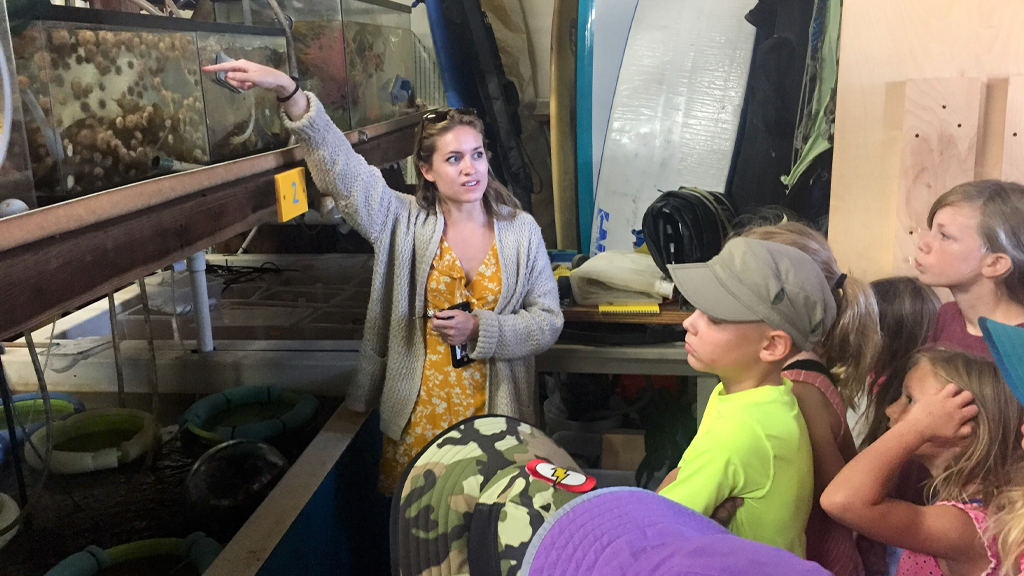
The Scripps Community Outreach for Public Education (SCOPE) program was founded by two graduate students in 2001 to fill a need for community engagement and establish permanent education and outreach opportunities at Scripps Institution of Oceanography at the University of California (UC) San Diego. As it is not a formalized student group nor designation of the institution, the SCOPE program operates through the approval and support of facilities and offices at Scripps. Since its inception, SCOPE has grown significantly in presence and impact within the Scripps and San Diego communities, while retaining its volunteer-driven roots. Its mission has broadened from loosely defined outreach to a program centered around four specific goals:
(1) foster scientific curiosity in—and STEM education opportunities for—today’s youth and the broader public, especially to meet the needs of underserved communities and demographics traditionally underrepresented in science;
(2) spread understanding of and appreciation for scientific practices;
(3) promote environmental stewardship; and
(4) provide graduate students and researchers opportunities to share their scientific knowledge with the public.
In striving to meet these goals, SCOPE serves as a dedicated pipeline for the public to connect with the scientific community at Scripps Institution of Oceanography for authentic, volunteer-led, hands-on learning experiences and facility tours. By employing an educational approach that connects graduate students and researchers directly with the public, SCOPE also provides an avenue for scientists to engage broader audiences in their work and improve their informal science communication skills.
These goals comprise the official SCOPE mission statement and were specifically designed in 2018 to align with the commitments of Scripps, UC San Diego, and the National Science Foundation regarding education and diversity in STEM. SCOPE’s mission reflects the increasingly important role of STEM outreach acknowledged by national agencies (National Research Council 2011). We hope that this program model can serve as a scaffold for other institutions interested in incorporating outreach programs into graduate training and increasing their local community’s awareness of and appreciation for scientific practices.
Programmatic Description
SCOPE is a program for STEM outreach and education that hosts cost-free events for participating groups who are interested in learning about the research conducted at Scripps Institution of Oceanography. Events may contain multiple tours or activities that are led by volunteer researchers including graduate students, staff, and faculty at Scripps. For details on program logistics see “Programmatic Operations” section.
Events are split into two broad categories based on where they take place: off-campus and on-campus. Off-campus events include guest speaker presentations at schools, senior centers, STEM career fairs, and other public organizations (e.g., the Boys Scouts of America, Rotary Club). The greatest benefit of off-campus events is that they increase access to STEM outreach for groups that might not otherwise be able to visit our institution (Program Goal 1). Since 2020, the reach of off-campus activities has been further extended to participants across the country using virtual platforms, including Zoom, Skype, and Google Hangouts.
On-campus activities represent the majority of SCOPE events. Options include: 30- to 45-minute tours of research facilities, interactive activities, and Meet and Greets with scientists. We make every effort to assign volunteer tour guides with expertise aligned with visitor interests. These events take advantage of the benefits of place-based learning by providing participants with hands-on immersion in novel, active research environments (Paris et al. 1998). These on-campus offerings are listed below, with the first two being the most popular.
- Ellen Browning Scripps Memorial Pier Tour. On this tour, visitors learn about historical and current research efforts in climate monitoring. The focus can be geared toward biology, geology, chemistry, or physics of the oceans. Topics often covered include Marine Protected Areas (MPAs) in San Diego, marine ecology, geology of the beach cliffs and underwater canyons, ocean acidification, tides, or how the physical environment drives climate and biology.
- Hubbs Hall Experimental Aquarium Tour. This tour provides a glimpse into a true research environment as the facility is home to a wide variety of local species that are model organisms for ongoing research. Visitors learn about the biology and husbandry of the organisms as well as the research themes of the associated laboratory groups. Aspects of the ecology, evolution, physiology, and development of many animals are described, as well as how their biology may be impacted by global climate change. The tours conclude with an interactive touch tank containing native tide pool animals, a favorite activity among elementary school students. This tour option enables program volunteers to promote respect for wildlife in our environment (Program Goal 3). This allows participants to explore their curiosity of marine creatures in an exciting yet informal setting, encouraging discussion and facilitating the benefits of cooperative learning (Johnson and Johnson 2008).
- Scripps Collections Tours. SCOPE partners with the world-renowned biological and geological collections housed at Scripps. The collections include a space and time capsule, documenting the history of scientific exploration and global environments. Participants are led through an interactive, show-and-tell-style tour by expert collections managers that highlights the scientific research being conducted at Scripps, logistics behind the collection, and how scientific specimens/cores are analyzed.
- Local Beach Geology and Tidepools Tour. This tour uses Scripps’s natural surroundings as an outdoor laboratory in which guests explore the complexities of geology and geologic time and learn about local geological features such as the sea cliffs and tidepools. Volunteer tour guides link their research passions with visitor exploration of sand erosion, turbidite geologic deposits, and tide pools.
- Meet and Greet With a Scientist. SCOPE also connects participants directly with researchers, typically through on-campus research presentations and/or demonstrations, where volunteers demystify what it means to be and become a scientist by sharing their current projects as well as educational and career pathways. This discussion is especially important for guests from traditionally underserved and underrepresented communities in STEM (aligning with Program Goal 1). Meet and Greets also provide volunteers with opportunities to refine their science communication skills at varying levels of complexity, in alignment with Program Goal 4. The Meet and Greet format is easily replicable at any institution with ongoing research and can also be offered using virtual platforms.
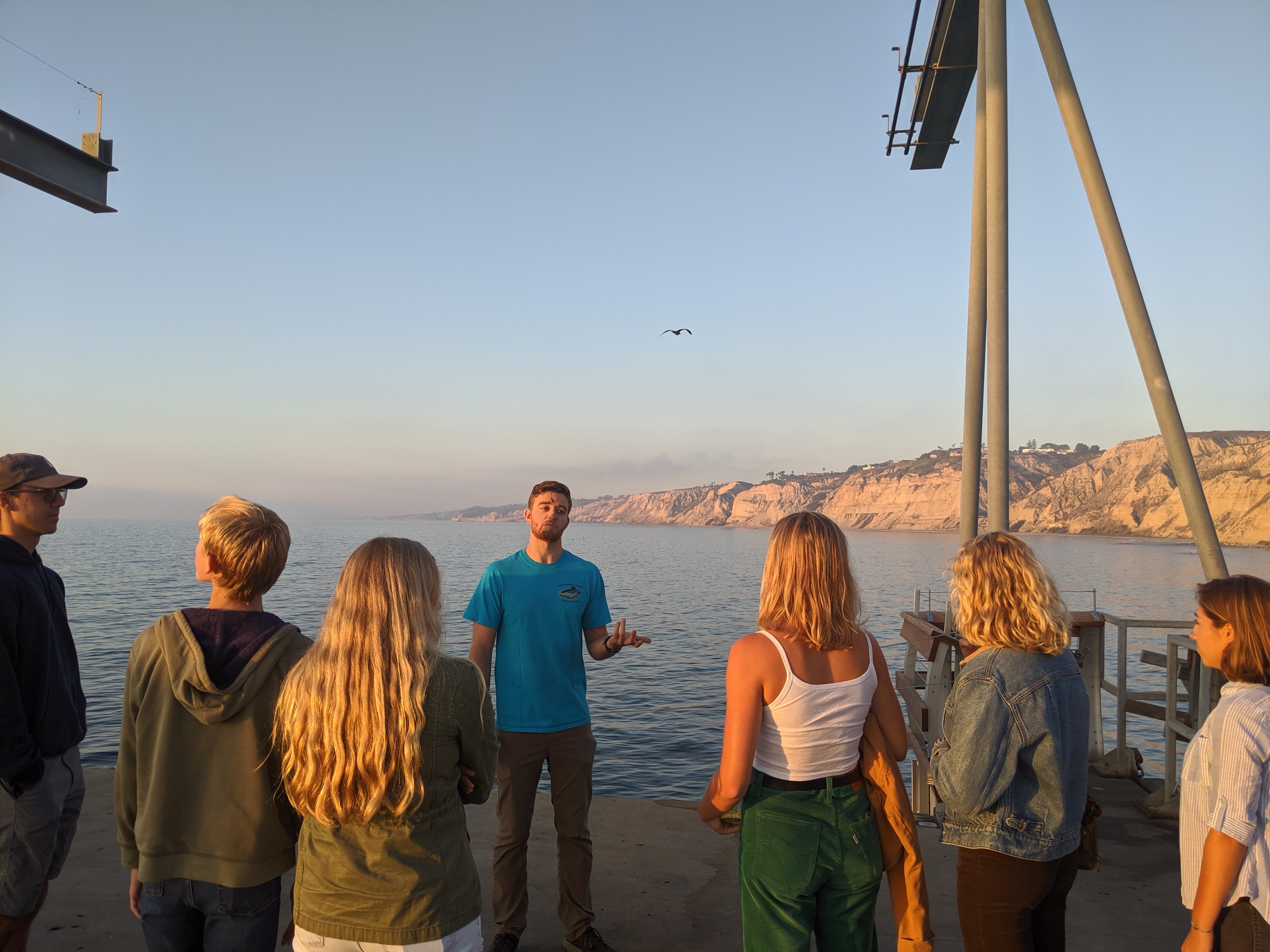
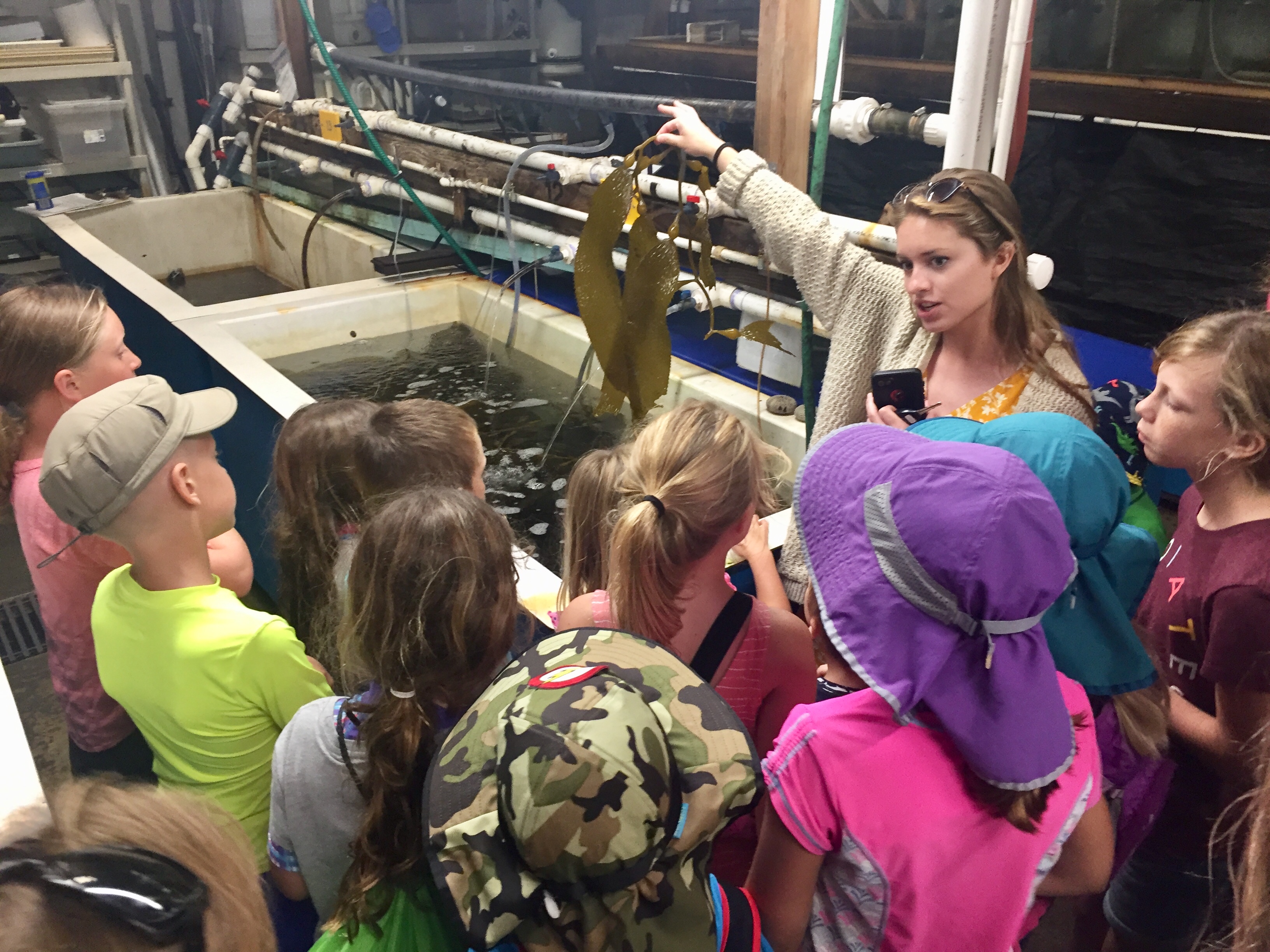
In addition to these onsite programs, SCOPE collaborates with multiple organizations to expand the reach of our offerings. Hands-on activities include a curriculum curated in partnership with the Climate Kids program of the Climate Science Alliance (CSA). These activities are designed for elementary and middle school participants to learn about the fundamentals of global climate change. Activities with CSA were developed in line with the Next Generation Science Standards (NGSS) and incorporate immersive learning strategies.
Current Programmatic Operations
The SCOPE program is overseen by a small team of graduate students (referred to as coordinators) who are paid stipends to manage web resources and incoming event requests (see Appendix A: SCOPE Event Request Form, see Supplemental Resources). Coordinators rotate through two-week shifts as “lead coordinator,” ensuring that academic obligations are balanced with responsibilities for program management. The lead coordinator’s responsibilities include managing the SCOPE email account, recruiting volunteers for scheduled events, and organizing upcoming events. The lead coordinator is responsible for gaining permission from the respective facilities managers for on-campus tours prior to events, to ensure both the safety of the visitors and the integrity of ongoing research.
The lead coordinator also follows up via email with the group leader requesting the event to provide a proposed event agenda to best fit their educational goals and other needs. Once the agenda is confirmed, events are added to a Google Calendar shared with research facility managers, and volunteers are recruited using an opt-in institutional Listserv for communication. When volunteers are not available, the coordinators serve as tour/activity guides. The lead coordinator also circulates a Post-Event Feedback Survey (see Appendix B, Supplemental Resources) to group leaders via email and ensures that final event data is recorded in a spreadsheet. Survey data helps identify areas for program improvement, which the coordinators can then act upon.
Currently, SCOPE is limited to hosting on-campus groups of 100 people or less based on space limitations and volunteer availability. Groups larger than 20 people are subdivided to comply with university-determined safety restrictions within research facilities. The smaller subgroup size also maximizes firsthand interactions and allows scientists to be more accessible to visitors and better answer their questions, humanizing the scientific process and promoting trust in research (in alignment with Program Goal 2). SCOPE limits the number of events to two per week during the school year to ensure that each group receives individualized attention. We increase this to as many as three events per week in the summer to accommodate the seasonal increase in event requests. Events are not scheduled on university holidays or other major events in the academic year, such as finals week. This scheduling framework has allowed SCOPE to provide just over 100 events per year while maintaining balance for program coordinators and volunteers. It enables volunteers to participate in outreach as part of Program Goal 4 without putting excessive demands on their time nor compromising their individual academic progress.
Maintaining a pool of enthusiastic volunteers is essential for the sustained success and evolution of the SCOPE program. To cultivate such a volunteer base, we host training events twice each academic year open to students, faculty, and staff in the Scripps community. Volunteer training is led by seasoned volunteers and/or the coordinators. This allows new volunteers to experience the tours from the perspective of participants, learn strategies for tailoring their scientific message for different audiences, and understand how their interests and expertise can be featured within the context of the SCOPE mission.
To supplement in-person training, SCOPE provides additional online resources for volunteers including virtual informational meetings and trainings, and “living documents” that give up-to-date information about tour content and ensure a level of consistency of program activities across volunteers. Prospective volunteers also have the option to “shadow” more experienced volunteers in person or remotely until they are confident leading activities independently. We have found that this collaborative approach helps foster community within the SCOPE volunteer pool, builds confidence in science communication skills for early career researchers, and lets volunteers experience how tours can be personalized in terms of their individual interests and expertise.
Additionally, SCOPE recognizes the time and efforts of volunteers by hosting a biannual volunteer appreciation party with food and raffle prizes. This informal gathering is a chance to encourage rapport among SCOPE volunteers, showcase the year’s events, and recognize the volunteers’ service to our community. It is also an opportunity for our partners (donors, facilities managers, etc.) to increase their awareness of the ongoing successes of the program and meet with SCOPE volunteers. The volunteer appreciation party is key to encouraging sustained volunteer engagement, opening dialogue among SCOPE leadership and members, and welcoming enthusiasm for outreach. The magnitude at which this program operates through a primarily volunteer-driven base is both novel and scalable.
Program Growth and Support
Since its inception in 2001, SCOPE’s reach has grown from just one event to over 100 events per year (Figure 1). As on-campus and local community enthusiasm increased during the late 2000s, SCOPE experienced a corresponding rapid rise in the annual requests for outreach events. This enthusiasm was likely fueled by added exposure through the program website and word-of-mouth recommendations (Figure 2a).
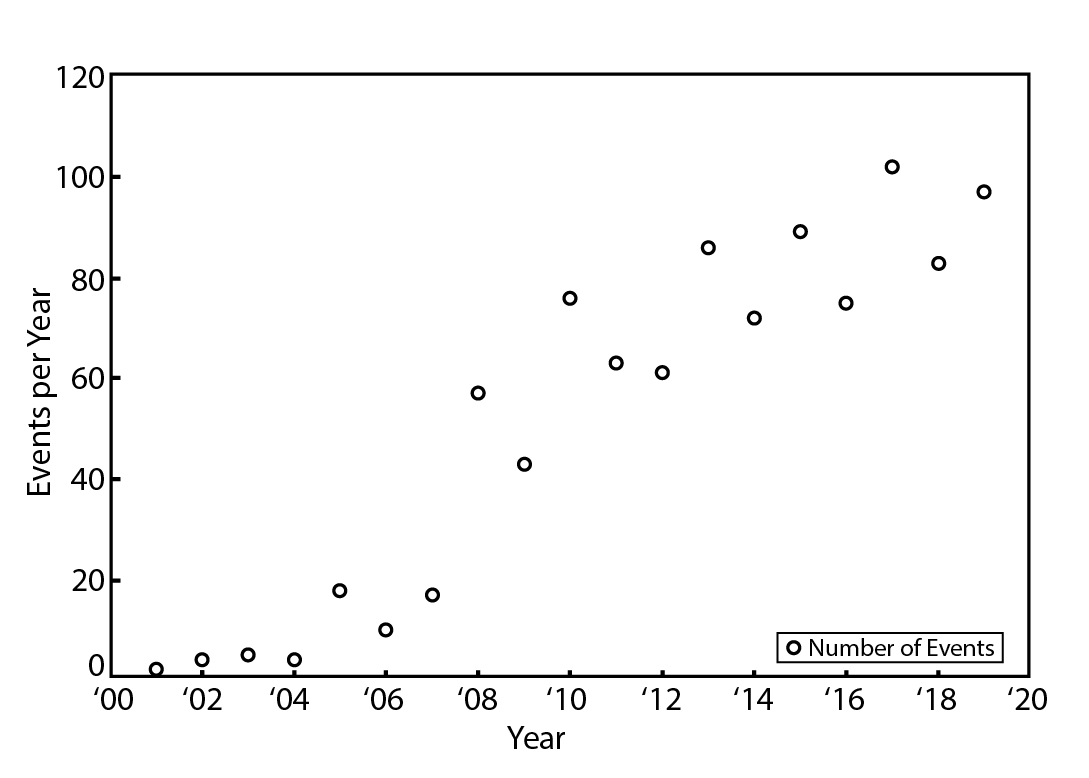

In 2008 SCOPE received a private endowment that continues to fund coordinator stipends as well as a scholarship program that brings students from Title I (Murphy 1971) schools (at least 40% of students from low-income backgrounds) to Scripps for educational tours. This award funds transportation and substitute teacher fees. The SCOPE program does not charge any fees for participation, so this funding opportunity permits teachers who may not otherwise have the support for costs associated with transportation and chaperones the opportunity to bring their students to visit Scripps (Program Goal 1). Twelve $500 scholarships are available each year. Through the development of this scholarship, SCOPE has been able to increase our connection with students in our community who are traditionally underserved and underrepresented in STEM. While SCOPE was able to operate without outside funding for several years, this endowment facilitated a large expansion of the program, growing from hosting 17 events in 2007 to 57 in 2008. See Figure 1 for details on SCOPE’s continued growth.
Program Impacts and Demographics
Impacts for Participants
To better understand achievement of SCOPE program goals, in 2018 we began implementing a voluntary Post-Event Feedback Survey with group leaders (see Appendix B, Supplemental Resources) and requesting additional information from visiting groups. This information has helped us better understand the communities we serve over time, in support of Program Goal 1. In the 2018–2019 academic year we hosted 180 events, from which we received 93 survey responses (52% response rate). The majority (69%) of SCOPE program participants during this time were K–12 student groups (Figure 2b). To date, most of our visitors have originated from San Diego County (80%), though our program has reached audiences across the United States and the globe (Figure 2c). According to group leaders, many groups (44%) include visitors who come from low-income backgrounds, speak English as a second language (33%), are first-generation college students (29%), and/or have disclosed disabilities (14%). For a number of respondents (14%), our program provided them with their first opportunity to see the ocean (Figure 2d).
The high proportion of positive responses to the Post-Event Feedback survey indicates that SCOPE provided a successful educational experience for participants at both on- and off-campus events. Nearly all (98%) of group leader respondents indicated they had a successful experience (Figure 3a). When asked whether they would consider participating in SCOPE in the future, 85% stated they would definitely return (Figure 3b). Of those that were unsure, or declined interest in returning, travel limitations to Scripps were frequently listed as the reason for this response (e.g., international visitors).

While not every group has specific learning objectives in mind when they arrange their event, those that do largely agree (77%) that this program was successful in meeting these objectives (Figure 3c). We’ve found that many groups’ learning objectives align with those of the SCOPE mission, with participant testimonials providing qualitative feedback on our success in achieving these outcomes. For example, in relation to Program Goal 2, one teacher wrote, “My kids were able to see the different types of sciences and other disciplines that are involved in studying marine life. They were also exposed to the researchers and [asked] questions of them directly. [This] is a large point of our science standards so seeing the ongoing research was valuable.” Another frequent participant stated, “[We] work with underserved communities in San Diego County to engage students as ocean stewards. The exposure [students] have [through] the SCOPE program is critical to helping us achieve our goal of a scientifically informed public,” relating to Program Goals 2 and 3.
These survey responses are also essential for the SCOPE team to implement improved practices to better address participant learning objectives and the overall program mission. Many of the shortfalls identified in these surveys relate to tour content accessibility. For example, over 17% of group leaders completing the survey stated that English was a second language for some of their students (Figure 2d); as a result, we have implemented Spanish translation for all of our online resources. We also cater volunteer selection to participant needs. In one instance, for example, a bilingual volunteer was able to give a tour to a visiting group in Korean—the native language for the group and the volunteer. Additionally, the overuse of scientific language has been identified in feedback testimonials as a barrier to student comprehension, particularly for younger groups (i.e., K-–12 groups, which make up 69% of SCOPE participants). To address these issues, we have augmented our training programs to include tools for volunteers to tailor the science to a range of audiences.
Volunteer Demographics
SCOPE strives to promote principles of equity, diversity, and inclusion through example. Our volunteer pool is an inclusive resource that represents researchers at various stages of their careers, with diverse fields of interest and expertise, and from different backgrounds. SCOPE collected volunteer demographics through an opt-in Volunteer Background survey in 2018 (47% response rate). Of the volunteers who offered information about their backgrounds, ~22% are first-generation college students (Figure 4a), and 63% are women in science (Figure 4b). SCOPE volunteers represent all major academic career stages, with graduate students making up the majority (75%) (Figure 4c). Our volunteer pool also represents a range of ethnic/racial backgrounds (Figure 4d). Thus, our program exposes participants to a wide array of scientists, which helps promote diversity and inclusion elsewhere and inspires participants to pursue STEM careers (Medin and Lee 2012; Pomeroy 1994).
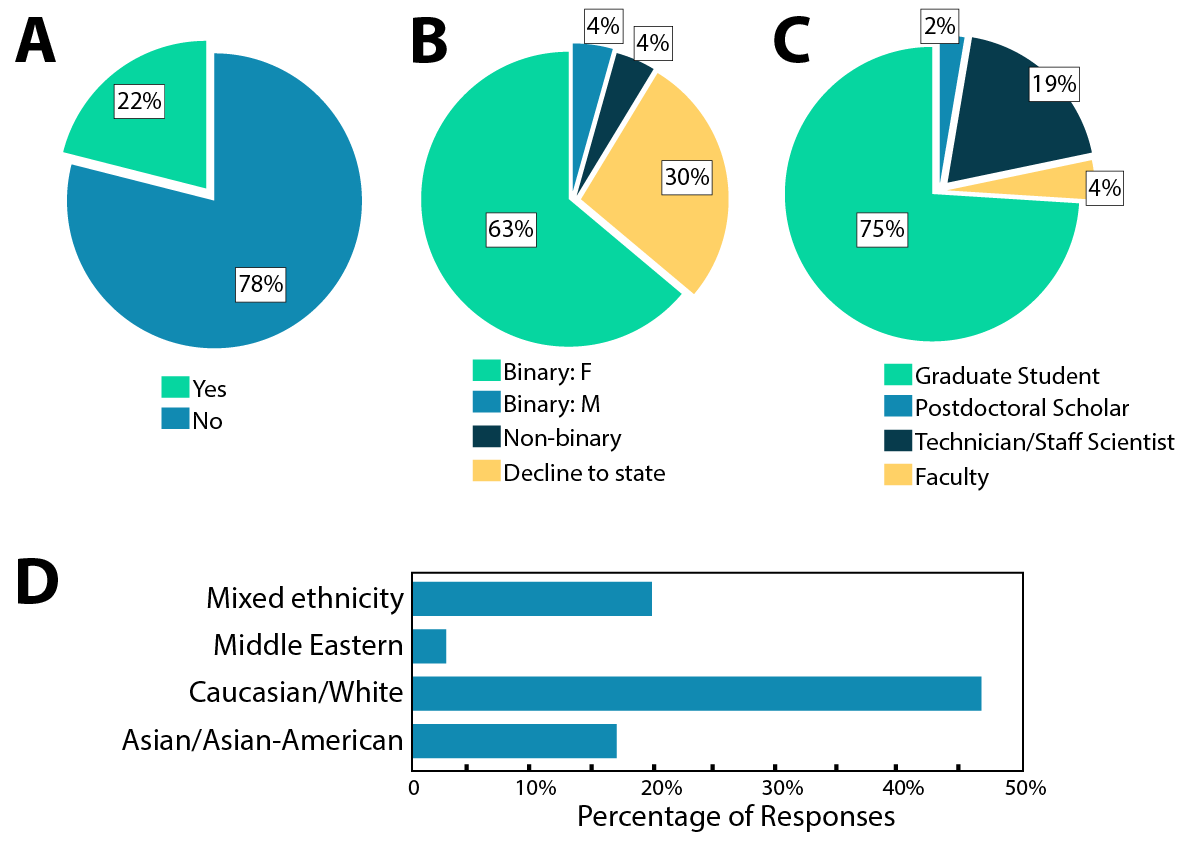
Impacts for SCOPE Volunteers
In addition to benefiting the public, SCOPE also strives to make outreach a worthwhile investment for—and valuable addition to—the scientific training of our volunteers. To better assess how SCOPE is meeting Program Goal 4, we circulated an optional Volunteer Impact Survey (see Appendix C, Supplemental Resources) in 2019, which had a 37% response rate. Findings include:
- The average amount of time that respondents have been active in the program is 3.1 years.
- The average number of tours given by a volunteer was 7.8 for that year.
- Respondents indicated that they have gained science communication skills by participating in SCOPE, with 94% of respondents replying “Yes.”
- Respondents also indicated that SCOPE has been a valuable addition to their training, with an average ranking of 4.4 for their experience (where 1 = Strongly Disagree and 5 = Strongly Agree).
Volunteers say they continue to be involved with SCOPE because it offers opportunities for them to practice communicating their science, and many find donating their time to the program a fulfilling way to expand access to STEM education within the community. The opportunity to lead activities through SCOPE provides an informal, low-pressure setting for volunteers to build confidence and polish communication skills. These skills are directly transferable to more formal academic settings (conferences, committee meetings, funding applications, etc.) and are an integral part of early career development.
Volunteer testimonials further illustrate the benefits that this program brings to the scientific community at Scripps. It is vital to the survival of SCOPE that we be accommodating of our volunteers’ academic obligations. Volunteer feedback indicates that our program structure has been effective in doing so, as one volunteer said, “I love outreach, and the way SCOPE is set up makes it easy to fit into my busy schedule.” Making STEM outreach convenient and accessible to our volunteers allows them to appreciate its benefits. One volunteer reported that their favorite part about being in SCOPE was, “Getting to meet a diverse variety of people—of all ages and backgrounds—and learn about how their perspectives/experience differ from mine, [SCOPE] has given me a better grasp on public speaking as well as communicating things in understandable terms.” Findings support that our volunteers recognize the value of strong communication skills and the importance of sharing research with the public. As one volunteer puts it, “[SCOPE] keeps me on my science communication toes and seems to lead to a broad community impact, which is important to me.” In addition, involvement in this program provides volunteers with additional perspective on the importance of their work and how community members can relate to their research. One volunteer wrote, “It’s a good reminder of the aspects of what I’m doing that are relevant to real people.”
Future Directions, Challenges, and Opportunities
While the SCOPE program has achieved our program goals in many ways, we continue to challenge ourselves to grow and improve. With phenomenal growth has come challenges. Future considerations for SCOPE center around continuing to increase our capacity to meet the growing demand for educational outreach, as well as extending our reach even more to communities traditionally underrepresented in STEM.
The most significant challenge that SCOPE faces is our limited capacity, which prevents us from accepting all incoming requests for tours. In 2019, we had to decline approximately 20% of requests due to scheduling conflicts and program limitations. Although possible, it is difficult to accommodate larger groups (over 100 people), as we aim to keep individual tour groups under 20 so that participants have more opportunity to interact directly with tour guides and gain more from the experience. However, we recognize that constraining group size restricts our capacity to meet demand for tours.
We also recognize that the costs associated with traveling to campus for in-person events, despite SCOPE being a cost-free program, can be a barrier for many groups. To address these constraints, SCOPE began working with external partners to develop online educational materials and presentations that can reach beyond our campus and extend to the classroom. In compliance with the university response to the COVID-19 pandemic, all on-campus or in-person SCOPE events have been prohibited since March 2020, which has led this virtual content creation to be further prioritized. Through the creation of virtual versions of our most popular tours (Ellen Browning Scripps Memorial Pier and Hubbs Hall Experimental Aquarium) and a switch to web-based Meet and Greet events, we have been able to continue to serve the public through this unprecedented period of online learning. We are actively generating additional virtual events and content, all of which will be permanently hosted on the SCOPE website as on-demand programming. We also plan to continue developing these virtual outreach tools once in-person tours resume as they increase the accessibility of Scripps research (Program Goal 1) and provide linkable in-classroom content.
Overall, the SCOPE program structure serves as a tractable model for implementing similar educational activities at other institutions. Those interested in implementing similar programs can replicate our structure and still have the flexibility to leverage their unique facilities, resources, and expertise. We believe our program is novel in terms of the scale at which we provide community outreach, its longevity (20 years), and that it is an entirely student-coordinated effort.
Our program architecture and the unique environment fostered at Scripps and UC San Diego has created positive learning experiences for the community and garnered praise and support from participants and volunteers alike. SCOPE is committed to serving local and global communities by providing STEM outreach opportunities, as well as promoting equity, diversity, and inclusion by providing educational opportunities and funding for those traditionally underrepresented in STEM.
Acknowledgments
We offer gratitude to our donors—your support has been essential to broadening our mission. We would also like to thank Kathleen Ritzman and Donna Shabkie for advocacy and council that has increased program impact, Scripps Diversity Initiatives Coordinator Keiara Auzenne, as well as Cheryl Peach and the Birch Aquarium at Scripps for their support and partnership. Finally, we would like to extend a sincere thank you to the current and past SCOPE coordinators, volunteers, collections and facilities managers, and many others without whom this program wouldn’t be and whose contributions are deeply valued.
Katherine T. Nesbit (knesbit@ucsd.edu) is a Scripps PhD graduate and former SCOPE coordinator, Wiley H. Wolfe is a PhD candidate and former SCOPE coordinator, Kelli K. Mullane is a PhD candidate and current SCOPE coordinator, Emelia J. Chamberlain is a PhD student and current SCOPE coordinator, Erik Saberski is a PhD candidate and current SCOPE coordinator, all at the Scripps Institution of Oceanography at the University of California San Diego in La Jolla, California. Brooke A. Rasina is a climbing photographer and a former SCOPE coordinator. Shelby A. Jones is a laboratory supervisor and educator with the Office of Archaeological Studies under the New Mexico Dept of Cultural Affairs, and a former SCOPE coordinator.
citation: Nesbit, K.T., W. Wolfe, K.K. Mullane, E.J. Chamberlain, B.A. Rasina, E. Saberski, and S.A. Jones. 2021. SCOPE: A volunteer-led STEM outreach program connecting communities to research. Connected Science Learning 3 (6). https://www.nsta.org/connected-science-learning/connected-science-learning-november-december-2021/scope-volunteer-led
Environmental Science NGSS Research STEM Informal Education


